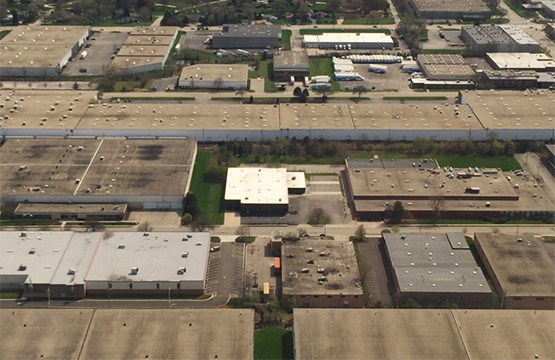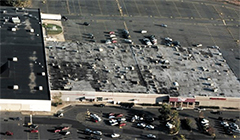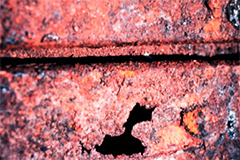

Summer is often a great time to conduct infrared inspections on low-slope roofs, so we thought this would be a great time to discuss the economics of doing low-slope roof inspections.
Fly into any city or drive around one and you will notice acres and acres of low-slope roofs. They are integral to most commercial and industrial buildings in particular. Many of these roofs develop a leak within the first year of installation and, typically because of the trapped moisture, they degrade until about ten years later when they are replaced!
 The costs of this situation are astronomical! A roof system is typically one of the most expensive parts of commercial and industrial buildings and—too often as the photograph shows—it is “out of sight and out of mind!” The costs are exorbitant including the obvious: damage to the contents of the building and disruption of work flow. But the real costs are often hidden. There is also the cost of the reduced roof life.
The costs of this situation are astronomical! A roof system is typically one of the most expensive parts of commercial and industrial buildings and—too often as the photograph shows—it is “out of sight and out of mind!” The costs are exorbitant including the obvious: damage to the contents of the building and disruption of work flow. But the real costs are often hidden. There is also the cost of the reduced roof life.
The materials used for most modern roof systems are designed to last at least twenty years. However, according to the National Roof Contractors’ Association, on average, a new roof in the United States lasts only half that long. Imagine throwing away half of the value of an asset like a roof every few years. Would you consider throwing away an asset such as your 401(k) every 10 years?
One of primary causes of this costly reduced life cycle is poor maintenance which results in a wet, degraded roof. Because thermography is a “condition-based” technology, maintenance decisions can be made using current information about the actual condition of the roof. Finding the wet insulation, replacing it, and repairing the roof to a dry condition is key to prolonging the life cycle, and every year the roof life can be safely extended is, literally, money in the bank.
 If you can just double the serviceable life of a roof, the economics are staggering. As they degrade the cost to repair or replace many roofs ends up increasing dramatically. And when it is time to replace the membrane, remember the deck and insulation may still be salvageable assets! The fact that many roofs—the ones that are well designed, installed and maintained—can last two or three times longer suggests we are paying too much for roofs over the life of the building. The bottom line is keep a roof dry and it can last twenty or more years!
If you can just double the serviceable life of a roof, the economics are staggering. As they degrade the cost to repair or replace many roofs ends up increasing dramatically. And when it is time to replace the membrane, remember the deck and insulation may still be salvageable assets! The fact that many roofs—the ones that are well designed, installed and maintained—can last two or three times longer suggests we are paying too much for roofs over the life of the building. The bottom line is keep a roof dry and it can last twenty or more years!
Thermography allows us to locate the wet insulation in a low-slope roof. In fact, it is the only technology that, when conditions are right, allows us to view the entire roof. With that information, repairs can be made to stop the leak and, importantly, to also replace the damaged or wet insulation, keeping the roof dry.
How can we find the wet insulation? Typically, we are looking for differences between the wet and dry insulation related to either thermal capacitance or conductivity. There are several ways this can be accomplished—more on that next month when we’ll discuss how to best conduct a Roof Moisture Inspection using Infrared Thermography.
Without thermography roofers and building owners are just making educated guesses about the condition of the roof. In today’s economy that could be a costly mistake. Why not get your imaging system out and see what is really going on up there, and then use that information to make an educated plan for the maintenance of your roof assets?